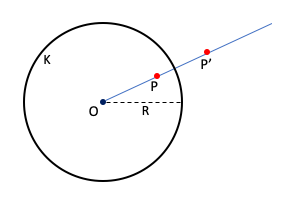We explore reflection in a circle. Let be a circle with center
and radius
. We call
the inversion circle. Every point
in the plane reflects to a point
across the inversion circle. The rule is that
is the unique point on the ray from
‘s center
through
such that
.
A few things of note. Reflection is its own inverse, meaning that reflecting a point twice yields that same point. Points that lie on circle reflect to themselves. Points in the interior of
(other than its center
) reflect to points in its exterior, and points in
‘s exterior reflect to points in its interior.
Since center of circle
lies at distance 0 from itself, its reflection is at infinity. To allow for this, the plane is extended with a single point
at infinity. Now,
reflects to
and
reflects to
.
We’ve looked at the reflection of points in the inversion circle , but in fact we can reflect any geometric figure — any set of points — in
. The reflection of a figure is the set of reflections of the points that comprise it. Suppose, for example, the figure is a circle. The reflection of a circle
not containing
‘s center
is another circle. If circle
does contain
, its reflection is a line.1 Accordingly, we broaden our definition of “circle” to include both circles and lines by regarding a line as a circle of infinite radius, in other words, a line is a circle that contains the point
. Then it becomes fair to say that the reflection of every circle is a circle.
The following program illustrates reflection of a disk in the inversion circle indicated by the thin red cylinder. The disk
is light gray and its reflection
is blue. When you drag
to a new position, its reflection updates when you release. You can change
‘s radius using the GUI slider.
The shape of disk ‘s reflection depends on whether it contains the center
of inversion circle
. When
lies in
‘s exterior,
‘s reflection is a disk in the plane. In contrast, when
lies in
‘s interior, its reflection is a disk that contains
. We render this as an annulus (ring) with the understanding that its outer boundary closes on itself at infinity. Lastly, when
lies on
‘s boundary,
‘s reflection is a half-plane whose boundary is a line. Since this half-plane includes the point
, it too is actually a disk. Just as circles, broadly defined, reflect to circles, disks reflect to disks.
- Since the reflection of
is
, if we assume
,
‘s reflection contains
making it a circle of infinite radius, that is, a line. ↩
